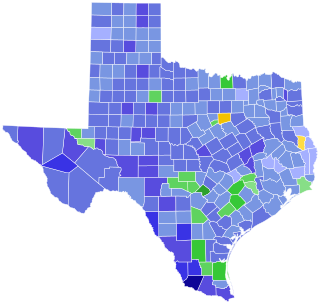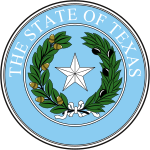
John Bowden Connally Jr. was an American politician who served as the 39th governor of Texas (1963–1969) and as the 61st United States Secretary of the Treasury (1971–1972). He began his career as a Democrat and later became a Republican in 1973.

Ralph Webster Yarborough was an American politician and lawyer. He was a Texas Democratic politician who served in the United States Senate from 1957 to 1971 and was a leader of the progressive wing of his party. Along with Senate Majority Leader Lyndon B. Johnson and Speaker of the House Sam Rayburn, but unlike most Southern congressmen, Yarborough refused to support the 1956 Southern Manifesto, which called for resistance to the racial integration of schools and other public places. Yarborough voted in favor of the Civil Rights Acts of 1957, 1960, 1964, and 1968, as well as the 24th Amendment to the U.S. Constitution, the Voting Rights Act of 1965, and the confirmation of Thurgood Marshall to the U.S. Supreme Court. Yarborough was the only senator from a state that was part of the Confederacy to vote for all five bills.

The 1988 United States Senate elections were elections for the United States Senate. Held on November 8, 1988, the 33 seats of Class 1 were contested in regular elections. In spite of the Republican victory by George H. W. Bush in the presidential election, the Democrats gained a net of 1 seat in the Senate. 7 seats changed parties, with 4 incumbents being defeated. The Democratic majority in the Senate increased by one to 55–45.

The 1964 United States Senate elections were held on November 3. The 33 seats of Class 1 were contested in regular elections. Special elections were also held to fill vacancies. They coincided with the election of President Lyndon B. Johnson by an overwhelming majority, to a full term. His Democratic Party picked up a net two seats from the Republicans. As of 2023, this was the last time either party has had a two-thirds majority in the Senate, which allowed the Senate Democrats to override a veto, propose constitutional amendments, or convict and expel certain officials without any votes from Senate Republicans. However, internal divisions would have prevented the Democrats from having done so. The Senate election cycle coincided with Democratic gains in the House in the same year.

The 1952 United States Senate elections was an election for the United States Senate which coincided with the election of Dwight D. Eisenhower to the presidency by a large margin. The 32 Senate seats of Class 1 were contested in regular elections, and three special elections were held to fill vacancies. The Republicans took control of the Senate by managing to make a net gain of two seats. However, Wayne Morse (R-OR) became an independent forcing Republicans to rely on Vice President Richard Nixon's tie-breaking vote, although Republicans maintained a 48–47–1 plurality. Throughout the next Congress, Republicans were able to restore their 49–46–1 majority. This was the third time, as well as second consecutive, in which a sitting Senate leader lost his seat.

United States gubernatorial elections were held on November 5, 2002, in 36 states and two territories. The Republicans won eight seats previously held by the Democrats, as well as the seat previously held by Minnesota governor Jesse Ventura, who was elected on the Reform Party ticket but had since renounced his party affiliation. The Democrats won 10 seats previously held by the Republicans, as well as the seat previously held by Maine governor Angus King, an independent. The elections were held concurrently with the other United States elections of 2002.

The 1966 Maryland gubernatorial election was held on November 8, 1966. Incumbent Democratic governor J. Millard Tawes was unable to seek a third term in office. In the election to succeed him, George P. Mahoney, a controversial segregationist, emerged from the Democratic primary due to splintered support for the two major candidates. Baltimore County Executive Spiro Agnew, was nominated by the Republican Party as their gubernatorial candidate. Mahoney and Agnew squared off, along with independent candidate Hyman A. Pressman. Ultimately, Agnew was victorious over Mahoney, with Pressman a distant third. This year was the last time that the state of Maryland elected a Republican governor until 2002. Agnew was later nominated for vice president by the Republican National Convention, per Richard Nixon's request, in 1968, an election he and Nixon won.

The 1934 United States Senate election in Texas was held on November 4, 1934. Incumbent Democratic U.S. Senator Tom Connally was re-elected to a second term. Connally fended off a competitive primary challenge from U.S. Representative Joseph Weldon Bailey Jr. on July 28 before facing only nominal opposition in the general election.

The 1972 Texas gubernatorial election was held on November 7, 1972, to elect the governor of Texas. Incumbent Democratic governor Preston Smith ran for reelection, but lost renomination to businessman Dolph Briscoe. Smith was overwhelmingly rejected in the Democratic primary, taking fourth place with only 8% of the vote amid the fallout from the Sharpstown scandal. Briscoe went on to win the general election by a relatively small margin, winning 48% of the vote to Republican Henry Grover's 45%. Raza Unida candidate Ramsey Muniz won 6%.

The 1992 United States presidential election in New Jersey took place on November 3, 1992, as part of the 1992 United States presidential election. Voters chose 15 representatives, or electors to the Electoral College, who voted for president and vice president.

The 1968 Texas gubernatorial election was held on November 5, 1968, to elect the governor of Texas. Incumbent Democratic governor John Connally did not run for reelection to a fourth term, so the election pitted Democrat Preston Smith against Republican Paul Eggers. Smith was easily elected, winning 57% of the vote to Eggers' 43%.

The 1964 Texas gubernatorial election was held on November 3, 1964, to elect the governor of Texas. Incumbent Democratic governor John Connally was reelected to a second term, winning 74% of the vote to Republican Jack Crichton's 26%.

The 1962 Texas gubernatorial election was held on November 6, 1962, to elect the governor of Texas. Incumbent Democratic governor Price Daniel was running for reelection to a fourth term, but was defeated in the primary by John Connally. Although Connally was easily elected, Republican Jack Cox's 46% of the vote was the highest received by any Republican candidate for governor since George C. Butte in 1924.

The 1972 United States presidential election in Texas was held on November 7, 1972, as part of the 1972 United States presidential election. Incumbent Republican President Richard Nixon overwhelmingly won the state of Texas with 66.20% of the vote, to the Democratic Party candidate George McGovern's 33.24%, thus giving him the state's 26 electoral votes. This result made Texas 9.8% more Republican than the nation-at-large. This was the first time a Republican won the state of Texas since Texas-born Dwight D. Eisenhower won it in 1956, even as Democrat Dolph Briscoe won the gubernatorial election on the same Ballot.

The 1968 United States presidential election in Texas was held on November 5, 1968. All 50 states and the District of Columbia, were part of the 1968 United States presidential election. The state chose 25 electors to represent them in the Electoral College, who voted for president and vice president.

The 1957 United States Senate special election in Texas was held on April 2, 1957, to complete the unexpired term of Senator Price Daniel, who resigned to become Governor of Texas. Interim Senator William Blakley did not run for re-election. Ralph Yarborough won the race with a plurality of the vote; no majority was required.

United States gubernatorial elections were held on November 8, 2022, in 36 states and three territories. As most governors serve four-year terms, the last regular gubernatorial elections for all but two of the seats took place in the 2018 U.S. gubernatorial elections. The gubernatorial elections took place concurrently with several other federal, state, and local elections, as part of the 2022 midterm elections.

The 1928 United States Senate election in Texas was held on November 6, 1928. Incumbent Democratic U.S. Senator Earle Mayfield ran for re-election to a second term.

The 2022 Texas House of Representatives elections were held on November 8, 2022, to elect representatives from all 150 House of Representatives districts across the U.S. state of Texas. It was held alongside numerous other federal, state, and local elections, including the 2022 Texas State Senate election. The winners of this election served in the 88th Texas Legislature, with seats apportioned according to the 2020 United States census.

The 2008 Texas Senate elections took place as part of the biennial United States elections. Texas voters elected state senators in 16 State Senate districts. The winners of this election served in the 81st Texas Legislature. The elected senators served four-year terms in the Texas Senate.























